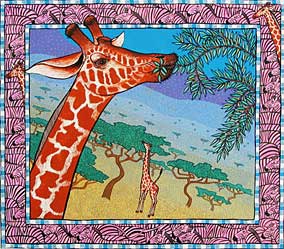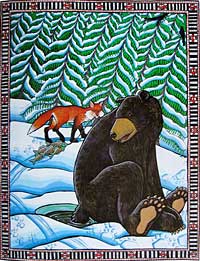 |
How do you know what animals look like?
Though I often stylize them to a certain degree, I still like to paint different species with some accuracy, so I always use photographic reference while working. I started cutting out and sorting magazine photographs when I was twelve and now have 4 drawers of a filing cabinet jammed full. I also have lots of animal books, and now I use the Internet, as well. I don't copy pictures. If I'm drawing a bear, I spread a bunch of bear pictures in front of me and refer to them as I make up my rough pencil drawings.
Reference-wise, Before & After was the craziest project since each page had at least twenty animal species. The dining-room table (my work table) was completely covered with pictures for 9 months. Guests had to eat on their laps in the living room. How long does it take you to finish a book?
Anywhere from 7 to 12 months, working pretty steadily - 9-months average, just like a baby.
Do you make a lot of money?
No, not for the time spent. To make a decent living, most illustrators need to do several books a year. Sometimes an illustrator is offered a flat fee for a book, but unless this is generous and up front, a portion of a book's royalties and an advance on those royalties is preferable. Some books do better in the marketplace than anyone could have predicted, and the odd book takes off like a rocket - for those books, the continuing return in royalties can be a wonderful thing. The downside, of course, is that no one seems able to predict which books those will be (and if you know anyone who can make such predictions, please send me their number!).
Would you consider illustrating something I have written?
I'm sorry, but, no, since I almost always write my own material. Beyond that, publishers generally take a dim view of preconceived matches between illustrator and writer. Part of a publisher's expertise is the ability to choose the perfect illustration style to go with a particular story. In fact, in most cases, writer and illustrator have no contact whatsoever.
Do you sell your original illustrations?
I sure do. ( click here) |
 |
Do you ever make art on the computer?
Many of the photographs in I Found a Dead Bird are actually photo-illustrations I created digitally ( see how I did it!) and The Rumor was partly done on computer ( see how I did it!). Over in the Meadow was my first completely digital children's book ( see how I did it!). I curse myself now for not having switched over, at least partially, for Before & After since it required a few exact replications of backgrounds. I've spent my entire working life being extraordinarily careful not to spill cups of coffee or drops of brush-rinsing water on works in progress so I won't ever, ever have to do something twice, (life is just too short) - and here I'd set myself up to paint each and every background two times! It was torture. I have made some sample illustrations. Now what?
 First, research in the library or on-line children's publishers. Don't forget to look for educational publishers and children's magazines that frequently need single illustrations and are more likely to give an unpublished illustrator a break. Make copies of your art to send out. Don't send slides and never send out original artwork. If you would like to illustrate books, it helps to include among your samples a series of 3 or 4 illustrations of a single work to show continuity in your style. It also helps enormously if you can include samples of lively, active children (I know, I know - my own people-drawing skills are appalling, but take my word for it). If you have published work, include tear-sheets in your package. Publishers of both books and magazines keep active files of illustrators' work; if they like yours, they'll want to keep something on file. You would, though, like to know their reactions to your work, so include in your package an SASE. Some people add a preprinted checklist of responses for a publisher to tick off and return. Some of these responses might be:
We like your work
We like your work, but it doesn't fit our needs
We'll keep your work on file
We are not looking for illustrators right now
We don't feel your work is right for us
Good luck!
|
 |



